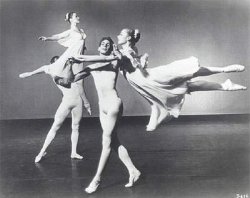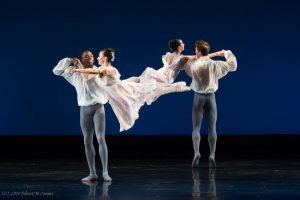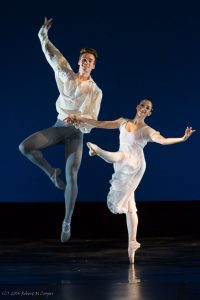Looking Back to Move Forward: Staging Antony Tudor’s Continuo (1971) – by Elizabeth McPherson
Posted in: Guest Essay

 In the Fall of 2014, for the Dance Program here at Montclair State University, I staged Antony Tudor’s Continuo (1971), from the Labanotation score (a written form for documenting dance). The staging of Continuo was a meaningful experience for me on many levels. It connected my past, in terms of research and dance training, to my current students, who will be carrying dance into the future. It reconnected with my ballet background, even though I spend more time in the world of modern dancers today. And it was an opportunity to work closely with Lynne Grossman (a fellow Montclair State faculty member who served as rehearsal director) and our wonderful cast of student dancers.
In the Fall of 2014, for the Dance Program here at Montclair State University, I staged Antony Tudor’s Continuo (1971), from the Labanotation score (a written form for documenting dance). The staging of Continuo was a meaningful experience for me on many levels. It connected my past, in terms of research and dance training, to my current students, who will be carrying dance into the future. It reconnected with my ballet background, even though I spend more time in the world of modern dancers today. And it was an opportunity to work closely with Lynne Grossman (a fellow Montclair State faculty member who served as rehearsal director) and our wonderful cast of student dancers.
Antony Tudor (1908-1987) is considered to be one of the choreographic geniuses of the 20th century. Born in England, he did not start studying dance until his teen years, eventually finding his way to Marie Rambert’s school in London and joining her company, The Ballet Club, in 1929. It was here that he choreographed two of his most enduring and revered works, Jardin aux Lilas (1936) and Dark Elegies (1937). The New York City-based Ballet Theatre, later called American Ballet Theatre, contracted Tudor to set three ballets for their 1939 season. He set sail for the USA a few weeks after Britain entered World War II, in one of the last civilian boats allowed to cross the Atlantic in normal passenger service. This began his long association with American Ballet Theatre. Tudor also spent many years teaching at the Metropolitan Opera Ballet School and The Juilliard School.
Often called the master of the psychological ballet, his style also extends beyond the psychological, which one can see in the more abstract Continuo. Tudor created his own steps, and ways of doing steps, that fall within the parameters of ballet but that do not quite precisely follow the traditional ballet lexicon. He was also known for not giving preparations for turns, lifts, and jumps, so that they seem to come from nowhere, creating fluid phrasing. His choreography is very difficult, but should look effortless.
Antony Tudor has fascinated me since my years as a student at Juilliard. He had been a colleague and/or teacher of many of my teachers there, including Alfredo Corvino, Laura Glenn, Linda Kent, Daniel Lewis, and Risa Steinberg. He died during my first year, and was often spoken about with great reverence and awe. As I gave thought to what I might want to stage at Montclair State for the Fall 2014 repertory season, my mind kept returning to Continuo. Originally choreographed for students at Juilliard, I first saw it performed by ABT’s Studio Company in 2008 at the 100th anniversary celebration of Tudor’s birth. Before the dance began that afternoon, I did not have high expectations; I thought it might be trite, given the music of Pachelbel’s overplayed Canon in D. Much to my delight, however, it was sheer poetry from beginning to end, as if the music had been composed for this dance alone.
I suggested Continuo as possible repertory to other Montclair State faculty, and all were intrigued but understandably concerned because the dance is onpointe, and we had never before done a pointe ballet at Montclair State. We had never even seen our students on pointe. I asked Lynne Grossman if she would help me with rehearsals as she had much experience dancing professionally on pointe. To begin with, we created a list of female Montclair State dancers whom we thought would be most likely to have strong enough pointe work, and sent an email to them over the summer, suggesting that they practice their pointe work if they would be interested in auditioning for the piece in September. The dance calls for a cast of three women and three men, and we were hoping to double cast.
September rolled around, and it was time to audition. Lynne and I ran the auditions during two of the slots for ballet classes, and students who wished to audition came to one of those two classes. Lynne and I began with a regular ballet barre to warm the students up and then asked the women to put on pointe shoes. We taught excerpts from the ballet, and began to see who would be most capable, best with partnering, and best able to embody the style and convey the expression of the dance. After the audition, Lynne and I had many lengthy discussions. We looked at heights of dancers and which men and women might work best together. There were a couple of issues with academic classes conflicting with rehearsals. We ended up with two full casts and three understudies (two women and one man), the cast members ranging from freshmen to seniors. They were all enthusiastic and dedicated throughout the process, remembering the details of choreography and timing with the precision of professional dancers. We generally only had one two-hour rehearsal a week, so quick learning and remembering was essential.
At the first rehearsal, I distributed an article on Antony Tudor that I wrote and published several years ago. [“Antony Tudor: Pillar of Twentieth Century Ballet.” Dance Teacher Magazine, August 2007: 105-106.] I wanted the students to begin by understanding the context of his career in the framework of dance history. I used primarily the Labanotation score to teach the dance, building upon the phrases that were taught at the audition and moving forward from there. Particularly to check spacing and partnering, I also used a video provided by the Dance Notation Bureau of Joffrey II performing Continuo as staged from the Labanotation score. There were occasional spots where the arms, for instance, were performed and documented differently in the video than in the notation. In these cases, I went with the notation score because that is the primary source used when staging a dance from Labanotation. In addition, this notation score did not have standard facing “pins,” which indicate the direction the dancer should be facing after a turn. With the numerous turns and turning lifts, I used the video to be sure of the spatial direction. Lynne and I counted at first, instead of using the music, slowly working up the dancers’ speed and confidence and then adding the music. MSU Dance faculty member Christian Von Howard assisted us with some of the partnering. Before long, the dance was complete, however, with time being short, the dancers were only able to run the full piece a couple of times before the date arrived for the coaches from the Tudor Trust to attend rehearsal.
The Tudor Trust owns the rights to all of Antony Tudor’s ballets. Because I staged the dance through Labanotation, our contract was with the Dance Notation Bureau in cooperation with the Tudor Trust. Amanda McKerrow and John Gardner were designated as our coaches by the director of the trust, Sally Bliss. They had both danced with American Ballet Theatre for many years, rising to the ranks of Principal and Soloist respectively, and they both knew and worked with Tudor. They also happen to be married! Our students, Lynne, and I had a wonderful learning experience with Amanda and John. They were relaxed and easygoing, but exacting. The version they knew differed slightly from the older, notated version, and so we worked together to decide what would be best for our students in the two extended rehearsals we had with them. Amanda and John were excited to see some of the characteristically “Tudor” steps that had gradually turned into more standard ballet steps through the years. They reminisced, told stories about Mr. Tudor, gave visual images, and worked on some of the partnering steps the students had not quite mastered. They nurtured the dancers to breathe life into the dance. A dance truly lives through performance, and Lynne and I began to see our dancers invest themselves fully into the lyric nature of the dance so that it became a living force, and not just steps strung together.
Montclair State faculty member Neil Baldwin interviewed Amanda and John on video one afternoon after rehearsal was over, and we were fortunate to hear more about their careers and their work with Antony Tudor. [*See below for link to the video.] He was a tough director, often pushing dancers to deep places emotionally, and not in a kind or gentle manner. Amanda and John indicated that they work to get the same depth from the dancers they coach and teach, but without using the harsher methods.
Our student costumer, Samantha LaScala, began attending rehearsals and measuring students. I saw a mock-up of the costumes a few weeks before the performance. The women’s costumes were made of blue chiffon with a pink skirt underneath, and the sleeves have a fluttery quality. They are based upon the original design by Lynn Hoffman, approved by Tudor. A drawing of the dress along with fabric swatches had been included with the Labanotation score. Under Samantha’s direction, the dresses turned out beautifully. I talked with a friend of mine, Ani Udovicki, who had danced the ballet as a student at Juilliard, coached by Tudor, and she remembered that he told the dancers they should be “like angels.” The fluttery sleeves made much more sense to me in this anecdotal context, because the manner in which they were attached down the back of the dress looked a little like an abstract version of wings. The men wore white, peasant-like shirts with gray tights and matching gray ballet slippers. Our faculty lighting designer, David O. Smith, also attended rehearsals, working with the lighting information given in the Labanotation score.
In the tension of the final tech rehearsals, we could see that the dancers were understandably nervous; however, we could also see that they were dancing from the heart, and that the dance was there – the choreography was clear to see. As the director, it was a very emotional process for me to let the dance go, because in the end, it was the dancers up on the stage — not me. As the dancers moved into the regular run of performances (November 19-23, 2014), Lynne and I made sure that they ran the dance in the studio just before performing it. This allowed them to get in sync with their partners, and to ease into the fluid quality. Continuo was the opening piece of the night, so the first couple was the first on stage for the whole concert, responsible for setting the mood and general impression. A high-pressure task indeed!
Our students gave strong performances, full of integrity and meaning. There are, of course, nuances that Lynne and I plan to work on for the spring performances (Danceworks, April 8-12, 2015); however, it is a fact of life that dancers are always seeking a perfection that is never fully achievable. The beauty comes in pursuit of that excellence – being the best one can be in a given moment, live, on stage, with no re-takes. And the “best one can be” comes from repetition — in the studio, day after day, always working. Through that work and, ultimately, performance, our dancers will carry Antony Tudor’s valuable legacy forward.

Elizabeth McPherson is an associate professor and coordinator of the BA in Dance at Montclair State University. She received her BFA from Juilliard, followed by an MA from The City College of New York, and a PhD from New York University. The author of The Bennington School of the Dance: A History in Writings and Interviews and The Contributions of Martha Hill to American Dance and Dance Education, 1900-1995, she has also written articles and reviews for Ballet Review, Dance Teacher Magazine, Attitude: The Dancers’ Magazine and The Journal of Dance Education. She is the Executive Editor of the new journal Dance Education in Practice.
The focus of Dr. McPherson’s research is teaching and learning in dance education with an emphasis on history. She has particular expertise in oral interviews, which make up significant portions of both of her books. Dr. McPherson has staged numerous 20th century dance works from Labanotation and other sources. Recent projects include Charles Weidman’s Lynchtown and excerpts from Anna Sokolow’s Scenes from the Music of Charles Ives. She is a board member of the Martha Hill Dance Fund and on the professional advisory committee of the Dance Notation Bureau. Performance credits include: Ernesta Corvino’s Dance Circle Company, Avodah Dance Ensemble, and the Louis Johnson Dance Theatre.
[*Follow the link to see and hear Amanda McKerrow and John Gardner discuss Antony Tudor and the choreographic process: Continuo.]
[Photographs of Montclair State University students performing Continuo by Robert M. Cooper.]
